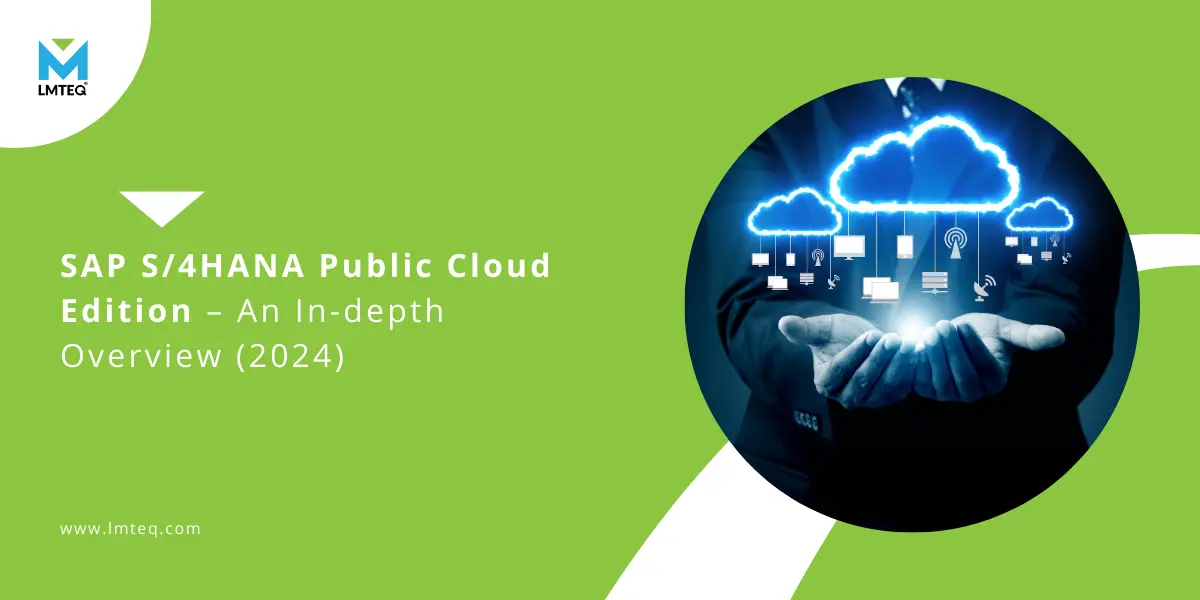Reimagine Your Business with SAP S/4HANA Public Cloud Edition.
As the demand for agile, cloud-based solutions accelerates, businesses must adapt or risk being left behind. Did you know that 85% of businesses will rely on cloud solutions by 2025, according to Gartner?
SAP S/4HANA Public Cloud Edition is designed to help businesses adapt, offering a flexible, scalable ERP system that powers real-time decision-making and drives growth.
With continuous updates and unmatched efficiency, it’s a smart choice for companies looking to stay ahead in the digital age. Let’s explore what makes SAP S/4HANA Public Cloud Edition a game-changer for modern enterprises.
Jump to any section to learn more about SAP S/4HANA Public Cloud : -
Understanding SAP S/4HANA Public Cloud – What is It?
SAP S/4HANA Public Cloud Edition is a next-generation ERP system hosted on the cloud, designed to bring together real-time data processing and analytics, supported by SAP’s powerful in-memory HANA database. Unlike the on-premise or private cloud versions, the public cloud edition focuses on delivering out-of-the-box functionality with faster implementation timelines and reduced total cost of ownership (TCO).
As a multi-tenant SaaS solution, multiple businesses share the same infrastructure but have completely segregated data and configurations. This ensures that organizations benefit from continuous innovation delivered through quarterly updates, without the complexities of managing upgrades or infrastructure.
Two-Tier ERP Strategy with SAP S/4HANA Public Cloud
The two-tier ERP strategy in SAP S/4HANA Cloud refers to a deployment model where a company uses a combination of S/4HANA on-premise (or private cloud) at the corporate headquarters (Tier 1) and S/4HANA on-premise at its subsidiaries, regional offices, or smaller business units (Tier 2). This strategy allows companies to leverage the robustness of a centralized ERP system for the core operations at HQ while maintaining flexibility and agility at their smaller units or regions with the cloud version.
Key aspects of the two-tier strategy in SAP S/4HANA Public Cloud
1. Centralized control – The corporate HQ has a centralized, integrated ERP system that manages critical business processes, financials, and compliance.
2. Agility and flexibility – Subsidiaries or smaller units run on a simplified, leaner S/4HANA Public Cloud environment, which is more adaptable to regional requirements.
3. Seamless integration – The two-tier structure allows for smooth data sharing and process integration between Tier 1 (HQ) and Tier 2 (subsidiaries).
4. Cost efficiency – Subsidiaries benefit from a lower-cost, scalable public cloud model while still being connected to the main ERP.
5. Faster deployment – The public cloud option for subsidiaries or new regions enables quicker go-lives compared to traditional on-premise systems.
Three-Tier Development Structure in SAP S/4HANA Public Cloud Edition
Tier 1– Cloud-Ready, Upgrade-Safe Development
- Usage of SAP Fiori Apps and SAP Business Technology Platform (BTP) to extend functionalities without customizing core ERP processes.
- Adoption of In-App Extensibility tools, allowing businesses to configure the system with UI changes, business rules, and process extensions in a safe and manageable manner.
- Ensuring seamless upgrades—SAP takes full responsibility for delivering quarterly updates without disrupting customer developments.
Benefits of Tier 1 Development
- Seamless updates – Since Tier 1 development is aligned with SAP’s standards, businesses can receive quarterly updates without worrying about compatibility issues.
- Faster time-to-market – The use of SAP’s pre-configured tools and APIs accelerates deployment and minimizes customization efforts.
- Cloud-compliant – Developments are secure, scalable, and compliant with cloud infrastructure, reducing operational risk.
Tier 2 – Usage of Custom Wrappers for Non-Released APIs
In some cases, businesses require functionalities that go beyond what SAP provides through its released APIs. This is where Tier 2 development comes in, offering a middle ground between flexibility and compliance. Tier 2 development is used when custom functionality requires non-released SAP APIs.
In Tier 2, custom wrappers are built to interact with these non-released APIs, ensuring that custom developments still adhere to cloud compliance standards. While more flexible than Tier 1, this tier requires careful governance to ensure that future upgrades are not impacted by the custom code.
Key Aspects of Tier 2 Development
- Utilization of SAP BTP to create custom extensions while staying within cloud-compliance frameworks.
- Development of custom wrappers around non-released APIs that aren’t natively supported by SAP S/4HANA Public Cloud.
- Risk mitigation: While Tier 2 development offers more flexibility, it must be carefully managed to avoid future upgrade disruptions.
Benefits of Tier 2 Development
- Enhanced functionality – Tier 2 allows businesses to go beyond standard SAP APIs, enabling advanced customizations tailored to specific needs.
- Maintained compliance – Despite custom developments, the use of wrappers ensures the system remains compliant with SAP cloud guidelines.
Tier 3 – Higher Risk Customizations
Key Aspects of Tier 3 Development
- Involves deep customization beyond the scope of SAP’s cloud-compliance standards.
- Typically leads to complex code that increases the risk of disruption during SAP’s regular software updates.
- Requires extensive testing during each update cycle to ensure compatibility.
Drawbacks of Tier 3 Development
- Higher risk – Tier 3 customizations pose a significant risk to system stability and can result in upgrade failures.
- Increased maintenance – The organization’s IT team must invest significant resources in ensuring custom developments remain compatible with future updates.
- Upgrade disruptions – Businesses may face delays in receiving new features and innovations due to the complexity of custom code.
SAP S/4HANA Public Cloud Architecture
1. SAP Fiori (User Interface Layer)
2. Application Layer (Business Logic)
3. Database Layer (SAP HANA In-Memory Computing)
How SAP S/4HANA Public Cloud Functions
Key Benefits of SAP S/4HANA Public Cloud Edition
1. Cost Efficiency
2. Faster Implementation and Flexibility
3. Scalability
4. Continuous Innovation
5. Enhanced User Experience
Value Add-Ons to SAP S/4HANA Public Cloud Customers
- AI and Machine Learning – SAP leverages advanced AI and machine learning algorithms to automate routine tasks and provide predictive insights.
- Real-Time Data Analytics – The in-memory HANA database provides businesses with the ability to conduct real-time analytics on live data, ensuring faster decision-making.
- Robust Security – SAP’s cloud infrastructure includes built-in security measures like encryption, access control, and compliance with industry regulations (e.g., GDPR).
Key Takeaway
SAP S/4HANA Public Cloud Edition is a flexible and scalable ERP solution that helps businesses streamline operations and adapt quickly to market changes. With its three-tier development structure, real-time data processing, AI integration, and robust security, it ensures continuous innovation while maintaining stability.

